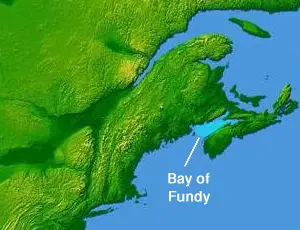 The Annapolis tidal power station was a government pilot project initially designed to explore harnessing energy from the sea that now contributes 20 MW (mega watts) to the electricity grid. Construction of the Annapolis project began in 1980, and was completed four years later, and is the first and only modern tidal generating plant in North America. It is located in the Bay of Fundy on the Atlantic coast of North America, on the northeast end of the Gulf of Maine between the Canadian provinces of New Brunswick and Nova Scotia.
The Annapolis tidal power station was a government pilot project initially designed to explore harnessing energy from the sea that now contributes 20 MW (mega watts) to the electricity grid. Construction of the Annapolis project began in 1980, and was completed four years later, and is the first and only modern tidal generating plant in North America. It is located in the Bay of Fundy on the Atlantic coast of North America, on the northeast end of the Gulf of Maine between the Canadian provinces of New Brunswick and Nova Scotia.
The Annapolis tidal power station is one of three tidal power plants in the world. Of its two counterparts, the largest one is located in France on the estuary of La Rance, near St. Malo, with a generating capacity of 240 MW on the incoming and outgoing tide, while the smallest is located in Russia on the White Sea, with a capacity of 0.5 MW.
The Annapolis plant is located on a small island at the mouth of the Annapolis River near Annapolis Royal, by the Bay of Fundy – a bay noted for producing the highest tides in the world. Tides at the Bay of Fundy’s eastern extremity, in the Minas Basin, average 12 metres but can reach up to 16 metres in height. With clockwork regularity, in harmony with the high-tide rhythm of the sea, the Annapolis station feeds the grid every 12 hours and 25 minutes. Over that twenty-four hour period, the Annapolis station comes on for five hours, then it’s off for seven hours, generating about 30 gigawatt hours each year, which is enough energy to power over 4,000 homes.
The potential for tidal power in the Bay of Fundy is quite large and a number of ambitious projects have been considered for sites in both the Cumberland Basin and Minas Basin. One proposal for the Minas Basin would span eight kilometres, be outfitted with 97 sluice gates, a three-kilometre long powerhouse with 128 double-effect turbines, and have an installed capacity of more than 5,000 megawatts.
Environmental studies are essential for tidal power plants as tidal barriers have impacts on fish populations, and cause silting at the head of a river. Tidal barriers effectively decrease turbulent energy in the tidal system causing sediments and other particles to drop from suspension and accumulate as deposits of mud, sand and silt. In the case of the enormous Minas Basin project, it would most likely have an impact upon the tides all along the coast.
Ocean Tides at the Bay of Fundy 1.2 minutes
